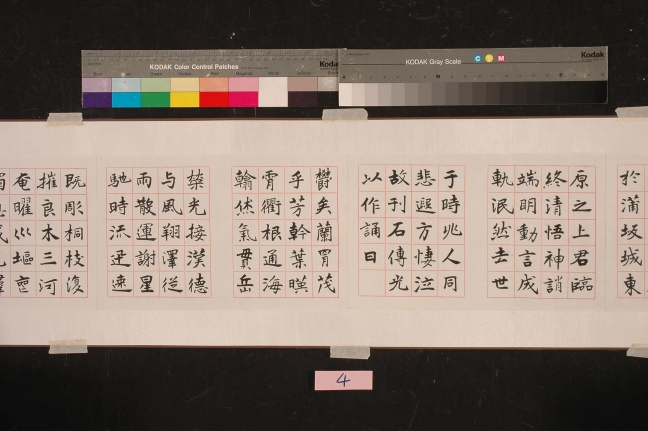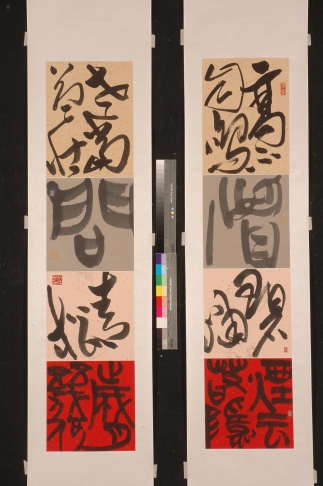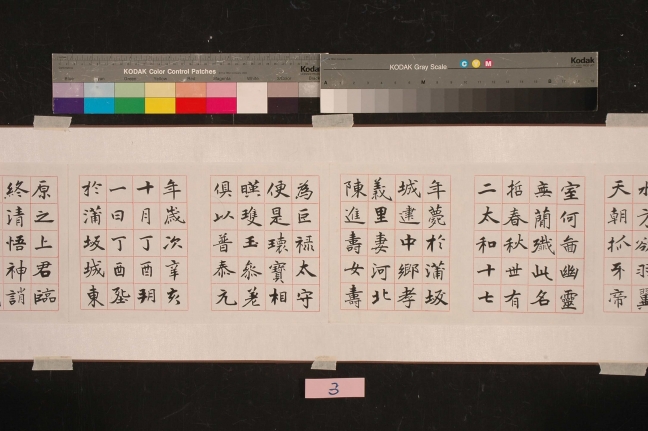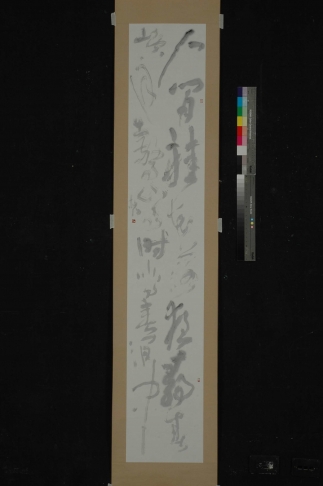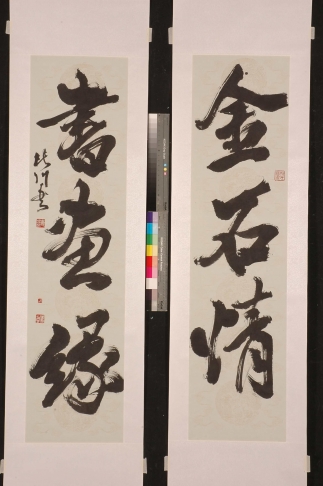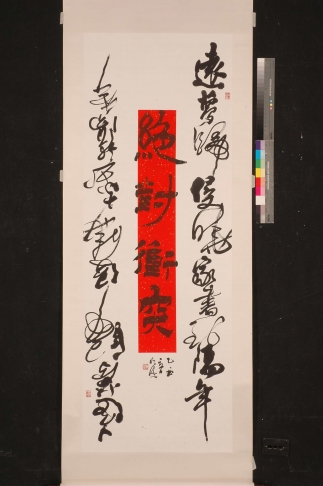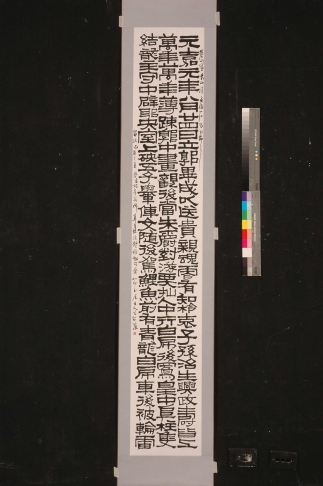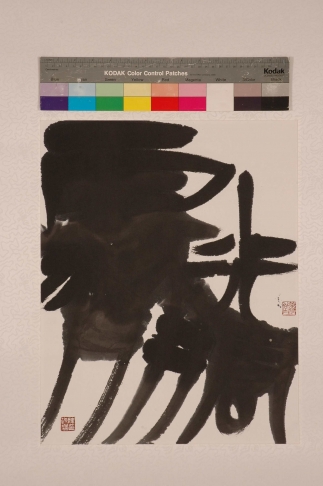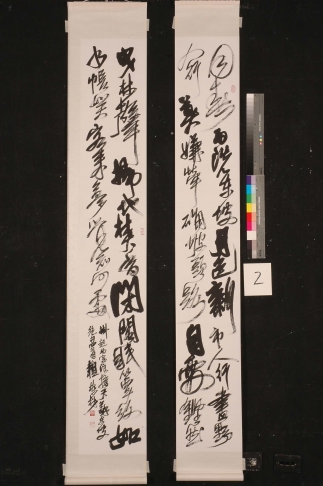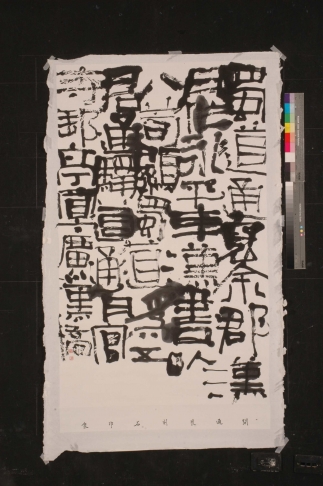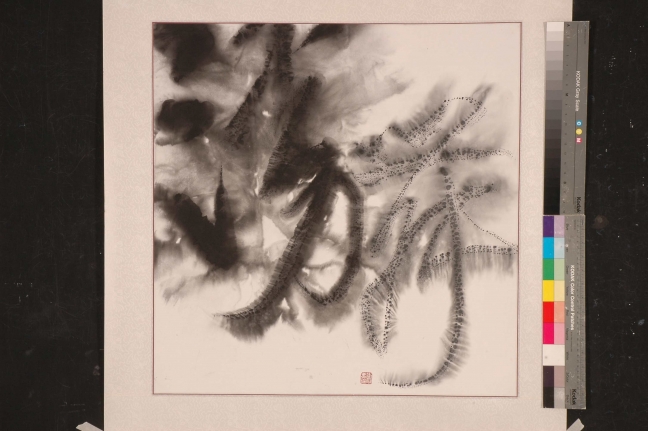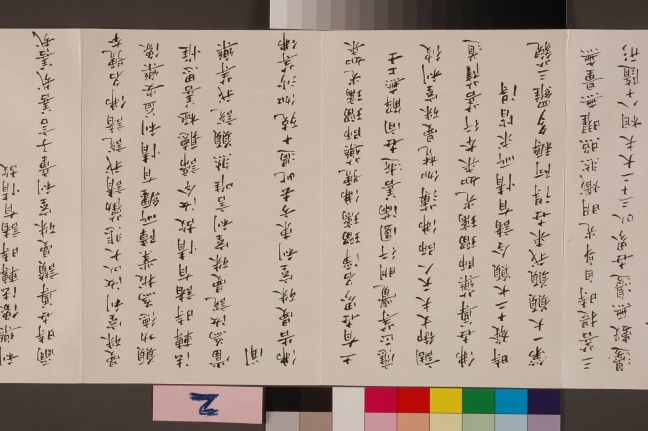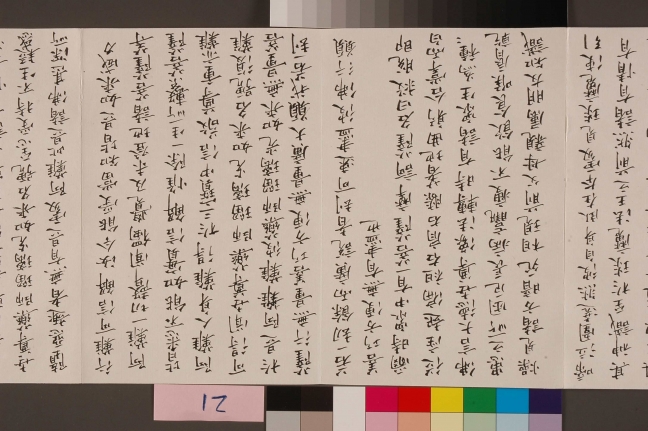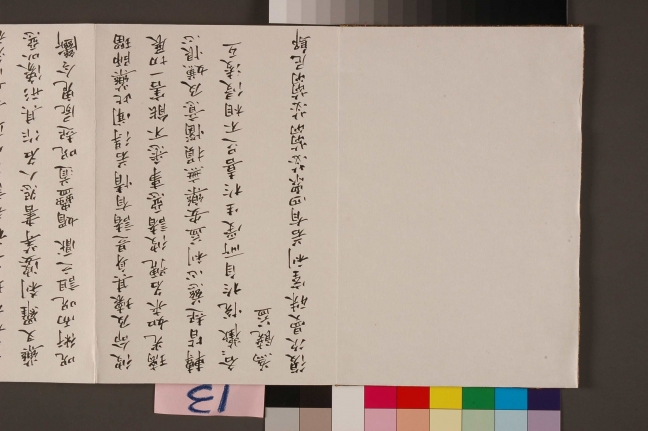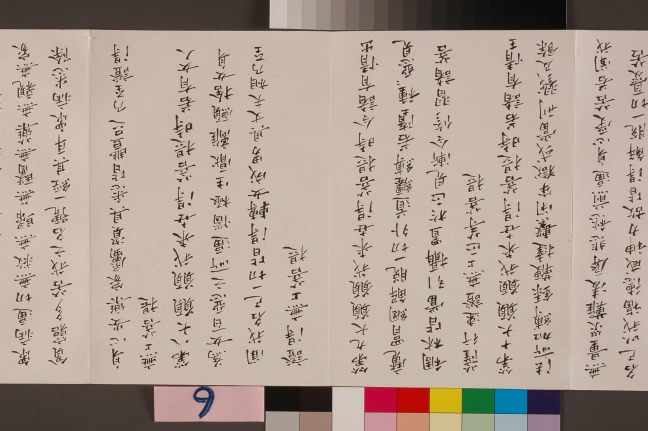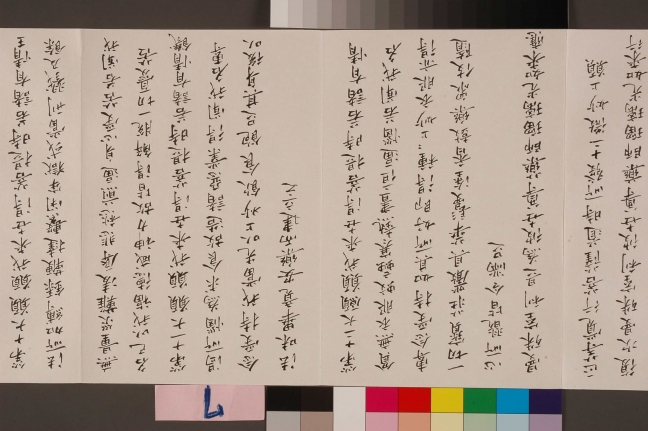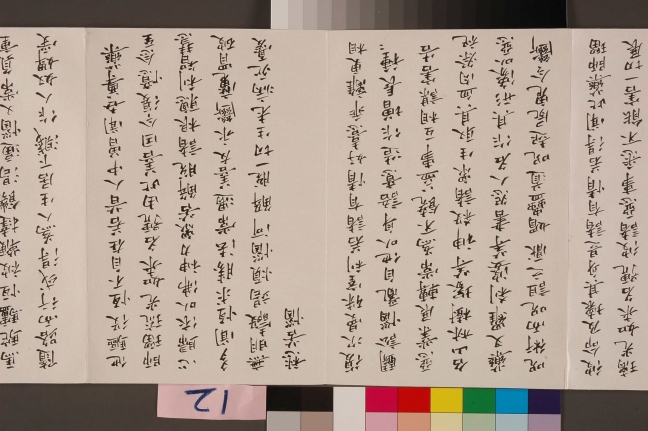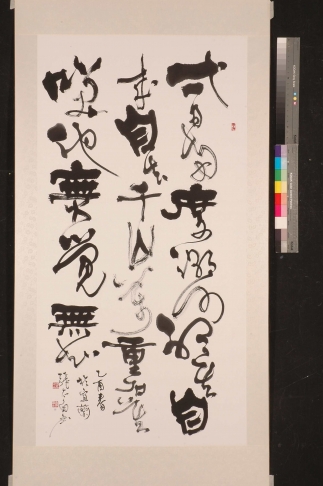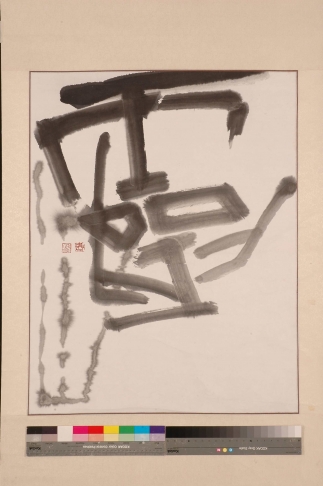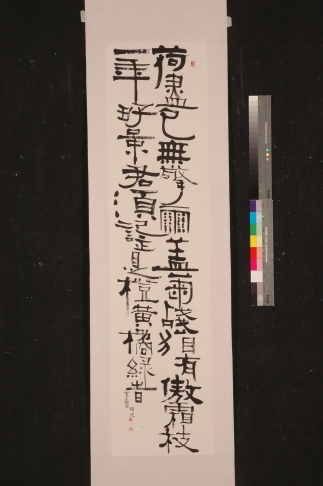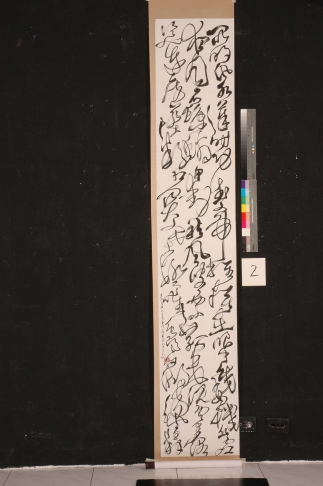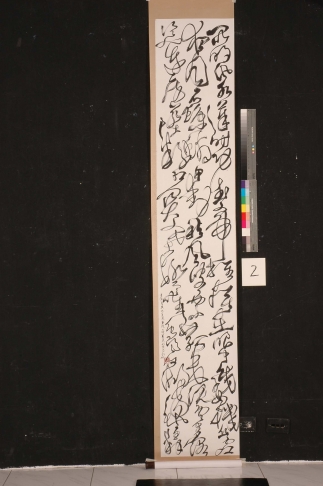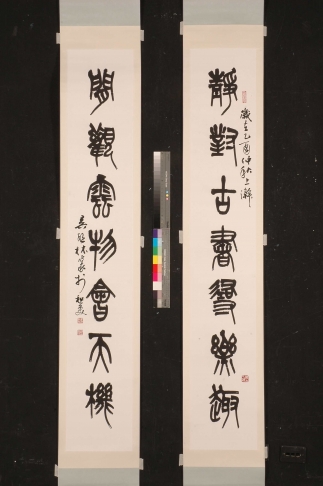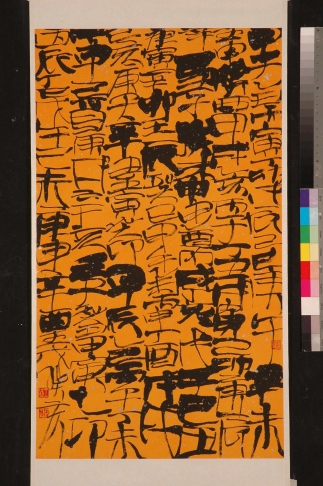《 2005 傳統與實驗書藝雙年展 》
2006.04.14~2006.06.02
09:00 - 17:00
《 2005 傳統與實驗書藝雙年展 》 展期: 2006-04-14 ~ 2006-06-02
地點: 週二至週日 上午10:00-下午5:00 今日簡體字的強勢全球化已讓傳統漢字之美面臨了被邊緣化的危機,而資訊文明的急速發展,已經讓鍵盤的輸入方式日漸取代了傳統的書寫活動;而不難想像的是,當文字本身脫離了形體的書寫和架構的思維,其結果將導致與書寫相關的筆墨之美與當代人漸行漸遠。為了傳達書藝所蘊含的深刻人文意涵,張揚書法藝術與文字的獨特美感,也為了激發民眾對書藝產生新的關注與興趣,進而重拾字裡行間的筆情和墨趣,關渡美術館特別就本次的展出內容和觀賞方式做了一些全新的規劃,並徵得本校藝科中心及科藝所之助,在本展中加入了動畫影像科技與互動裝置等設施,希望讓觀者經由多元的接觸方式,來體會傳統書藝的精神和奧妙,並一窺書藝在時代演變下的新軌跡。 展期: 2006-04-14 ~ 2006-06-02
地點: 週二至週日 上午10:00-下午5:00 今日簡體字的強勢全球化已讓傳統漢字之美面臨了被邊緣化的危機,而資訊文明的急速發展,已經讓鍵盤的輸入方式日漸取代了傳統的書寫活動;而不難想像的是,當文字本身脫離了形體的書寫和架構的思維,其結果將導致與書寫相關的筆墨之美與當代人漸行漸遠。為了傳達書藝所蘊含的深刻人文意涵,張揚書法藝術與文字的獨特美感,也為了激發民眾對書藝產生新的關注與興趣,進《2005傳統與實驗書藝雙年展》而重拾字裡行間的筆情和墨趣,關渡美術館特別就本次的展出內容和觀賞方式做了一些全新的規劃,並徵得本校藝科中心及科藝所之助,在本展中加入了動畫影像科技與互動裝置等設施,希望讓觀者經由多元的接觸方式,來體會傳統書藝的精神和奧妙,並一窺書藝在時代演變下的新軌跡。
地點: 週二至週日 上午10:00-下午5:00 今日簡體字的強勢全球化已讓傳統漢字之美面臨了被邊緣化的危機,而資訊文明的急速發展,已經讓鍵盤的輸入方式日漸取代了傳統的書寫活動;而不難想像的是,當文字本身脫離了形體的書寫和架構的思維,其結果將導致與書寫相關的筆墨之美與當代人漸行漸遠。為了傳達書藝所蘊含的深刻人文意涵,張揚書法藝術與文字的獨特美感,也為了激發民眾對書藝產生新的關注與興趣,進而重拾字裡行間的筆情和墨趣,關渡美術館特別就本次的展出內容和觀賞方式做了一些全新的規劃,並徵得本校藝科中心及科藝所之助,在本展中加入了動畫影像科技與互動裝置等設施,希望讓觀者經由多元的接觸方式,來體會傳統書藝的精神和奧妙,並一窺書藝在時代演變下的新軌跡。 展期: 2006-04-14 ~ 2006-06-02
地點: 週二至週日 上午10:00-下午5:00 今日簡體字的強勢全球化已讓傳統漢字之美面臨了被邊緣化的危機,而資訊文明的急速發展,已經讓鍵盤的輸入方式日漸取代了傳統的書寫活動;而不難想像的是,當文字本身脫離了形體的書寫和架構的思維,其結果將導致與書寫相關的筆墨之美與當代人漸行漸遠。為了傳達書藝所蘊含的深刻人文意涵,張揚書法藝術與文字的獨特美感,也為了激發民眾對書藝產生新的關注與興趣,進《2005傳統與實驗書藝雙年展》而重拾字裡行間的筆情和墨趣,關渡美術館特別就本次的展出內容和觀賞方式做了一些全新的規劃,並徵得本校藝科中心及科藝所之助,在本展中加入了動畫影像科技與互動裝置等設施,希望讓觀者經由多元的接觸方式,來體會傳統書藝的精神和奧妙,並一窺書藝在時代演變下的新軌跡。
《 2005 傳統與實驗書藝雙年展 》 展期: 2006-04-14 ~ 2006-06-02
地點: 週二至週日 上午10:00-下午5:00 今日簡體字的強勢全球化已讓傳統漢字之美面臨了被邊緣化的危機,而資訊文明的急速發展,已經讓鍵盤的輸入方式日漸取代了傳統的書寫活動;而不難想像的是,當文字本身脫離了形體的書寫和架構的思維,其結果將導致與書寫相關的筆墨之美與當代人漸行漸遠。為了傳達書藝所蘊含的深刻人文意涵,張揚書法藝術與文字的獨特美感,也為了激發民眾對書藝產生新的關注與興趣,進而重拾字裡行間的筆情和墨趣,關渡美術館特別就本次的展出內容和觀賞方式做了一些全新的規劃,並徵得本校藝科中心及科藝所之助,在本展中加入了動畫影像科技與互動裝置等設施,希望讓觀者經由多元的接觸方式,來體會傳統書藝的精神和奧妙,並一窺書藝在時代演變下的新軌跡。 展期: 2006-04-14 ~ 2006-06-02
地點: 週二至週日 上午10:00-下午5:00 今日簡體字的強勢全球化已讓傳統漢字之美面臨了被邊緣化的危機,而資訊文明的急速發展,已經讓鍵盤的輸入方式日漸取代了傳統的書寫活動;而不難想像的是,當文字本身脫離了形體的書寫和架構的思維,其結果將導致與書寫相關的筆墨之美與當代人漸行漸遠。為了傳達書藝所蘊含的深刻人文意涵,張揚書法藝術與文字的獨特美感,也為了激發民眾對書藝產生新的關注與興趣,進《2005傳統與實驗書藝雙年展》而重拾字裡行間的筆情和墨趣,關渡美術館特別就本次的展出內容和觀賞方式做了一些全新的規劃,並徵得本校藝科中心及科藝所之助,在本展中加入了動畫影像科技與互動裝置等設施,希望讓觀者經由多元的接觸方式,來體會傳統書藝的精神和奧妙,並一窺書藝在時代演變下的新軌跡。
地點: 週二至週日 上午10:00-下午5:00 今日簡體字的強勢全球化已讓傳統漢字之美面臨了被邊緣化的危機,而資訊文明的急速發展,已經讓鍵盤的輸入方式日漸取代了傳統的書寫活動;而不難想像的是,當文字本身脫離了形體的書寫和架構的思維,其結果將導致與書寫相關的筆墨之美與當代人漸行漸遠。為了傳達書藝所蘊含的深刻人文意涵,張揚書法藝術與文字的獨特美感,也為了激發民眾對書藝產生新的關注與興趣,進而重拾字裡行間的筆情和墨趣,關渡美術館特別就本次的展出內容和觀賞方式做了一些全新的規劃,並徵得本校藝科中心及科藝所之助,在本展中加入了動畫影像科技與互動裝置等設施,希望讓觀者經由多元的接觸方式,來體會傳統書藝的精神和奧妙,並一窺書藝在時代演變下的新軌跡。 展期: 2006-04-14 ~ 2006-06-02
地點: 週二至週日 上午10:00-下午5:00 今日簡體字的強勢全球化已讓傳統漢字之美面臨了被邊緣化的危機,而資訊文明的急速發展,已經讓鍵盤的輸入方式日漸取代了傳統的書寫活動;而不難想像的是,當文字本身脫離了形體的書寫和架構的思維,其結果將導致與書寫相關的筆墨之美與當代人漸行漸遠。為了傳達書藝所蘊含的深刻人文意涵,張揚書法藝術與文字的獨特美感,也為了激發民眾對書藝產生新的關注與興趣,進《2005傳統與實驗書藝雙年展》而重拾字裡行間的筆情和墨趣,關渡美術館特別就本次的展出內容和觀賞方式做了一些全新的規劃,並徵得本校藝科中心及科藝所之助,在本展中加入了動畫影像科技與互動裝置等設施,希望讓觀者經由多元的接觸方式,來體會傳統書藝的精神和奧妙,並一窺書藝在時代演變下的新軌跡。
張光賓
邀請書家 張光賓(1915年生) 四川達縣人。1945年重慶國立藝專三年制國畫科畢業。1969年入台灣故宮博物院書畫處工作。1987年11月以研究員退休。擅書畫,著有《中華書法史》、《書法藝術》、《花竹畫》、《元四大家》、《元代書畫史研究論集》及個人書畫作品集多種。 傳統類:草書陸放翁詩 釋文:草書學張顛,行書學楊風,平生江湖心,聊寄筆硯中,龍蛇入我腕,疋素忽已窮,餘勢向隱轔,此與嗟誰同。 款識:放翁句,乙酉秋月張光賓時年九十有一 印章:張光賓印、于寰九十、放輕鬆 96.5×53 cm 實驗類:喫虧是(福) 釋文:福(壽),糊塗增壽 款識:乙酉秋月張光賓時年九十又一 印章:張光賓印、于寰九十、有壽而享諸福、不誠無物、知白守黑、自然而然 137×70 cm 李文漢(1925年生) 上海美專畢業,安徽臨泉縣人,曾任中學教師及大學教授。獲國 際書畫大獎十次,曾獲香港政府頒受「金紫金」大獎。曾任教育部文藝獎評審委員及全國文藝金像獎評審委員。現任社團法人中國文化藝術國際交流協會理事長、全國現代水墨畫學會會長。 傳統類:行書李清照醉花陰中堂 釋文:薄霧濃雲愁永晝,瑞腦噴金獸。佳節又重陽,玉枕紗櫥半夜 涼初透。東籬把酒黃昏後,有暗香盈袖。莫道不銷魂,簾捲西風,人比黃花瘦。 印章:李氏、文漢、人長壽 11252.5㎝ 實驗類:狂草四言聯 釋文:裂破古今,橫行天下 款識:李文漢 印章:李氏、文漢 13530㎝×2 創作自述:學書:楷、行、草、隸、篆、漢竹木簡、狂草等。 大篆新創「羚觭金篆」,狂草能揮一幅「一筆狂」。國畫創新,由1950年李文漢創辦「中國現代水墨畫學會」起,全台中華藝術走向創新,走向中西藝術優點合壁,走向本土化,走向國際化,是李文漢的領導方針,也是自己奮鬥努力的目標。書法:雖未成立集體奮鬥,然李文漢個人,仍一直不斷向「現代」、「日新」、「大國文化」的理想前進。 廖禎祥(1926年生) 現任中國書法學會、中國標準草書學會及澹廬書會顧問,基隆書道會評議委員暨東寧臨池會及祥門書會會長。 傳統類:草書清劉熙載語 釋文:高韻、深情、堅實、浩氣缺一不可以為書 款識:劉熙載語廖萃庵 印章:廖萃庵、萃庵八十歲後書、寄懷墨痕 136×35㎝ 姜一涵(1926年生) 山東昌邑人。2003年大病復活號青山。師範大學文學士,文化大學藝術史碩士、博士候選,美國堪薩斯大學、普林斯頓美術考古系研究員。曾任文化大學美術系所教授兼系所主任,香港珠海學院、東海大學美術系、山東大學客座教授。教育部美育委員、考試院典試委員等職。1953年拜黃君翁夫子學山水。四十歲前多臨石濤、八大、龔賢及近代之齊白石、黃賓虹諸大家;出國後,得孟德里安、米羅、羅斯克、馬蒂斯之啟發最多。2003年秋於病榻上以錄音方式著《東方美學之「玄」、「妙」--易經美學》、《西方近代繪畫十講》、《中國繪畫美學十講》,另有《石濤畫語錄研究》、《石濤畫語錄句解義疏》、《元代奎章閣及奎章人物》。其書法從研究于右任、齊白石開其端,自1994年始著《書道美學隨緣談》,恐專家譏其紙上空談,乃立志學書。 傳統類:隸書五言聯 釋文:秦淮瀲灩,紫金崔巍 款識:此余光中先生遊南京時得句,藉書為聯二美併矣,二OO二年十月五日適兩岸國慶日之間,世事滄桑豈偶然哉?天山人逸中姜一涵于東海 印章:姜一涵、澤之、心齋 173×46㎝×2 實驗類:長江水 釋文:無邊落木蕭蕭下,不盡長江滾滾來/長江水 款識:此長江水三字之由來二OO五年仲秋節姜一涵/二OO五青山 印
張光賓
邀請書家 張光賓(1915年生) 四川達縣人。1945年重慶國立藝專三年制國畫科畢業。1969年入台灣故宮博物院書畫處工作。1987年11月以研究員退休。擅書畫,著有《中華書法史》、《書法藝術》、《花竹畫》、《元四大家》、《元代書畫史研究論集》及個人書畫作品集多種。 傳統類:草書陸放翁詩 釋文:草書學張顛,行書學楊風,平生江湖心,聊寄筆硯中,龍蛇入我腕,疋素忽已窮,餘勢向隱轔,此與嗟誰同。 款識:放翁句,乙酉秋月張光賓時年九十有一 印章:張光賓印、于寰九十、放輕鬆 96.5×53 cm 實驗類:喫虧是(福) 釋文:福(壽),糊塗增壽 款識:乙酉秋月張光賓時年九十又一 印章:張光賓印、于寰九十、有壽而享諸福、不誠無物、知白守黑、自然而然 137×70 cm 李文漢(1925年生) 上海美專畢業,安徽臨泉縣人,曾任中學教師及大學教授。獲國 際書畫大獎十次,曾獲香港政府頒受「金紫金」大獎。曾任教育部文藝獎評審委員及全國文藝金像獎評審委員。現任社團法人中國文化藝術國際交流協會理事長、全國現代水墨畫學會會長。 傳統類:行書李清照醉花陰中堂 釋文:薄霧濃雲愁永晝,瑞腦噴金獸。佳節又重陽,玉枕紗櫥半夜 涼初透。東籬把酒黃昏後,有暗香盈袖。莫道不銷魂,簾捲西風,人比黃花瘦。 印章:李氏、文漢、人長壽 11252.5㎝ 實驗類:狂草四言聯 釋文:裂破古今,橫行天下 款識:李文漢 印章:李氏、文漢 13530㎝×2 創作自述:學書:楷、行、草、隸、篆、漢竹木簡、狂草等。 大篆新創「羚觭金篆」,狂草能揮一幅「一筆狂」。國畫創新,由1950年李文漢創辦「中國現代水墨畫學會」起,全台中華藝術走向創新,走向中西藝術優點合壁,走向本土化,走向國際化,是李文漢的領導方針,也是自己奮鬥努力的目標。書法:雖未成立集體奮鬥,然李文漢個人,仍一直不斷向「現代」、「日新」、「大國文化」的理想前進。 廖禎祥(1926年生) 現任中國書法學會、中國標準草書學會及澹廬書會顧問,基隆書道會評議委員暨東寧臨池會及祥門書會會長。 傳統類:草書清劉熙載語 釋文:高韻、深情、堅實、浩氣缺一不可以為書 款識:劉熙載語廖萃庵 印章:廖萃庵、萃庵八十歲後書、寄懷墨痕 136×35㎝ 姜一涵(1926年生) 山東昌邑人。2003年大病復活號青山。師範大學文學士,文化大學藝術史碩士、博士候選,美國堪薩斯大學、普林斯頓美術考古系研究員。曾任文化大學美術系所教授兼系所主任,香港珠海學院、東海大學美術系、山東大學客座教授。教育部美育委員、考試院典試委員等職。1953年拜黃君翁夫子學山水。四十歲前多臨石濤、八大、龔賢及近代之齊白石、黃賓虹諸大家;出國後,得孟德里安、米羅、羅斯克、馬蒂斯之啟發最多。2003年秋於病榻上以錄音方式著《東方美學之「玄」、「妙」--易經美學》、《西方近代繪畫十講》、《中國繪畫美學十講》,另有《石濤畫語錄研究》、《石濤畫語錄句解義疏》、《元代奎章閣及奎章人物》。其書法從研究于右任、齊白石開其端,自1994年始著《書道美學隨緣談》,恐專家譏其紙上空談,乃立志學書。 傳統類:隸書五言聯 釋文:秦淮瀲灩,紫金崔巍 款識:此余光中先生遊南京時得句,藉書為聯二美併矣,二OO二年十月五日適兩岸國慶日之間,世事滄桑豈偶然哉?天山人逸中姜一涵于東海 印章:姜一涵、澤之、心齋 173×46㎝×2 實驗類:長江水 釋文:無邊落木蕭蕭下,不盡長江滾滾來/長江水 款識:此長江水三字之由來二OO五年仲秋節姜一涵/二OO五青山 印
相關專文
2005傳統與實驗書藝雙年展 2005 Chinese Calligraphy Biennial—Tradition and Experimentation 「書法」來自文字而超越文字,書法作品中的字雖然「意有所指」,但作為一種造型符號,本身的視覺美感和價值意義是可以單獨成立的。 文字的發明,開啟了人際溝通與知識傳播的新時代,它的工具性價值,在於為人們的思想/活動留下了可供追索的紀錄、讓訊息的傳遞/溝通跨越了時空的限制;在中國較為獨特的是,早在文字被發明應用之際,一種將文字推向「創意書寫」的藝術思維,及導向個人「寄情揮灑」的表現美學,幾乎也同時出現了。這種心思,無疑就是「書法」藝術的起點,而如何從「有為法」的文字中,窮盡書寫本身的樂趣與可能,如何透過書寫行為來展現情感與個性,並建構不同時代的文字美學,也變成了歷代書法家共同的藝術課題。 從古至今,書法的應用極廣,舉凡國家典章的頒布,文人雅士的交游酬作,到庶民百姓的日常生活,都可以看到它的身影。書法之為用,除了透過文字的敘述見證歷史與社會的發展,也不斷以一種藝術符號的身段體現出時代的美感和人文的精神。長期以來,它被視為中華藝術道統/東方文化精神的重要傳承和獨特表徵,然而,新世紀科工文明的發展與傳播技術的丕變,無可諱言已對書法藝術的創作實踐產生了明顯的衝擊。今日的書法家,能否嚴肅面對此一時代挑戰,並就發展課題重新思維,無疑也影響了其創作的走向與未來的歷史評價。 多年來,何創時書法藝術基金會致力於傳統書藝的收藏與推廣,千禧年來臨之際,因著眼於書藝傳承與未來發展而開始籌劃「傳統與實驗」書法展,有感於各方的好評和持續辦理的殷殷期待,基金會乃於次年將其正式定調為雙年展。2005年的「傳統與實驗書藝雙年展」延續創辦精神,邀請與徵選書家共襄盛舉,同時強調學術研究的水準與創作探索的規模。本展除了鼓勵及激發書藝創作,也期盼書家能從傳統的基礎上發揚實驗創新的精神,共創富有時代精神和特色的書藝作品。本屆參展藝術家同時展出傳統類書法和實驗性書藝各一件,也有將兩者結合成一件作品之例,這些作品除了質和量相當可觀,整體而言,也具現了當代書家兼重固本與再創的一種文化意識。 此次關渡美術館與何創時基金會共同主辦「2005傳統與實驗書藝雙年展」,除了基於對本展之策劃精神及價值意義的肯定,也希望藉由本館完善寬敞的空間及專業團隊的服務,讓書藝之美更能切入當代的詮釋系統,並以較活潑的方式來呈現。我們的看法是,今日簡體字的強勢全球化已讓傳統漢字之美面臨了被邊緣化的危機,而資訊文明的急速發展,已經讓鍵盤的輸入方式日漸取代了傳統的書寫活動;而不難想像的是,當文字本身脫離了形體的書寫和架構的思維,其結果將導致與書寫相關的筆墨之美與當代人漸行漸遠。 為了傳達書藝所蘊含的深刻人文意涵,張揚書法藝術與文字的獨特美感,也為了激發民眾對書藝產生新的關注與興趣,進而重拾字裡行間的筆情和墨趣,關渡美術館特別就本次的展出內容和觀賞方式做了一些全新的規劃,並徵得本校藝科中心及科藝所之助,在本展中加入了動畫影像科技與互動裝置等設施,希望讓觀者經由多元的接觸方式,來體會傳統書藝的精神和奧妙,並一窺書藝在時代演變下的新軌跡。 Chinese calligraphy derives from the written character but transcends the functionality of it. While the written character functions as an index to meanings, as a form of visual sign, Chinese calligraphy can also be appreciated in its own right for its beauty and artistic values. The invention of writing inaugurated a new era of communication and of knowledge distribution. The practical value of writing consists in its function to keep records of human thoughts and activities, enabling acts of communication and knowledge distribution to cross over time and space. Nevertheless, one thing that distinguishes Chinese writing in particular is that almost since their invention, Chinese written characters have always been valued for more than their practical function to convey meanings, as calligraphy has turned the act of writing itself into a form of creative practice or artistic self-expression - this is precisely the starting point of calligraphic art. Such concerns have been developed into a number of key aesthetic issues: How can one think beyond the 'usefulness' of writing, and explore all other possibilities of writing as well as the pleasure of it? How can one use the act of writing as a means of expressing one's own sensibility and personality, and thence go on to establish an 'aesthetics of writing' for each specific period of time? These are some of the main issues which have perplexed calligraphers for centuries. Since Antiquity the art of calligraphy has been embedded in the fabric of Chinese cultural life on all levels, widely employed on occasions such as the inauguration of state laws, gift-exchange between the intelligentsia, and everyday communications among ordinary people. Apart from textually recording historical and social events,Chinese calligraphy has also been used as an art form which articulates the aesthetics and cultural spirits of its corresponding eras. For a long time, calligraphy has been widely recognized as a defining symbol of Chinese arts as well as a significant carrier of Oriental cultural heritage. However, industrialization and changes in the techniques of communication have, without a doubt, posed severe threats to the practice of calligraphic art of our time. Calligraphers today are therefore confronted with a critical situation with regard to the survival and continuing relevance of their craft. How contemporary calligraphers overcome this crisis, or whether or not calligraphers of our time can take on this challenge and re-define the relevance of calligraphy to our cultural life, will also have significant bearings on their current practice, as well as on their future places in the history of calligraphic art. Since it was founded, the Ho, S Foundation of Calligraphic Arts has dedicated itself to the collecting of masterpieces of Chinese calligraphy, as well as the promotion and education of calligraphic art. In an attempt to acknowledge the legacies of calligraphic art and to ponder future developments of the practice, the Foundation began to plan for the exhibition Tradition and Experimentation as the new millennium approached. In 2001, the Foundation officially announced Tradition and Experimentation to be a Biennial in response to the overwhelmingly positive feedback and stated expectations for continuing commitments. The 2005 Chinese Calligraphy Biennial Tradition and Experimentation is held in the spirit of its founding motto as it invites calligraphers to create works that would echo the spirits and characteristics of our time. The 2005 Biennial is constituted by works of calligraphic art in two major categories. Whereas the first category comprises works of renowned calligraphers invited by the Foundation, the second category consists of winners of a competition which is also part of this event. All participating calligraphers demonstrate their masterful skills in traditional-style practice; at the same time they also explore creative and experimental possibilities to the greatest of scopes. Each of the participating calligraphers contributes to the 2005 Biennial a piece of traditional-style work and a piece of experimental work; some of the calligraphers even combine these different styles in one piece as a way of experimentation. By and large, the 2005 Biennial has attracted a remarkable number of participating calligraphers whose works have all achieved artistic brilliance. Their works can also be seen to define the collective consciousness of contemporary calligraphers: that is, to give equal considerations to both tradition and experimentation in their practice. The Kuandu Museum of Fine Arts has accepted the invitation to co-host the 2005 Biennial of Tradition and Experimentation with the Ho, S Foundation of Calligraphic Arts in recognition of the spirit and cultural significance of this exhibition. We hope that our spacious modern exhibition room, equipped with our technologies of multi-media presentation, would give the Exhibition a contemporary outlook. And in doing so we hope to highlight the relevance of calligraphy to the cultural life of our time. In the midst of the announcement of the United Nations regarding their decision to use only simplified Chinese characters after 2008, it is our great concern that the rising hegemony of the simplified characters, along with the fast-growing digital culture which is gradually replacing hand-writing with key-in, will eventually lead to marginalization of our traditional characters which have always been inscribed with the beauty and spirit of Chinese culture. As writing becomes separated from the visual form that gave meanings to the characters in the first place, it may, understandably, result in the regrettable parting of calligraphic art from our contemporary society. The aim of the 2005 Chinese Calligraphy Biennial is multifold: to communicate the profound humanist spirits embedded in Chinese calligraphy, to demonstrate the distinct beauty of traditional Chinese characters and calligraphic art, to stimulate our viewers' interests in the art of Chinese calligraphy, and finally, to encourage wider participation in such practice. Thanks to the generous support from the Center for Art and Technology as well as the Graduate School of Arts and Technology, Taipei National University of Arts, The Kuandu Museum of Fine Arts have been able to present the 2005 Chinese Calligraphy Biennial with multi-media facilities including animation technologies and interactive media. With the most advanced presentational techniques, we hope to provide our viewers with brand new ways of approaching Chinese calligraphy, enabling our viewers to experience the spirits and beauty of traditional calligraphy as well as to witness the evolution of Chinese calligraphic art to its latest state.
相關專文
2005傳統與實驗書藝雙年展 2005 Chinese Calligraphy Biennial—Tradition and Experimentation 「書法」來自文字而超越文字,書法作品中的字雖然「意有所指」,但作為一種造型符號,本身的視覺美感和價值意義是可以單獨成立的。 文字的發明,開啟了人際溝通與知識傳播的新時代,它的工具性價值,在於為人們的思想/活動留下了可供追索的紀錄、讓訊息的傳遞/溝通跨越了時空的限制;在中國較為獨特的是,早在文字被發明應用之際,一種將文字推向「創意書寫」的藝術思維,及導向個人「寄情揮灑」的表現美學,幾乎也同時出現了。這種心思,無疑就是「書法」藝術的起點,而如何從「有為法」的文字中,窮盡書寫本身的樂趣與可能,如何透過書寫行為來展現情感與個性,並建構不同時代的文字美學,也變成了歷代書法家共同的藝術課題。 從古至今,書法的應用極廣,舉凡國家典章的頒布,文人雅士的交游酬作,到庶民百姓的日常生活,都可以看到它的身影。書法之為用,除了透過文字的敘述見證歷史與社會的發展,也不斷以一種藝術符號的身段體現出時代的美感和人文的精神。長期以來,它被視為中華藝術道統/東方文化精神的重要傳承和獨特表徵,然而,新世紀科工文明的發展與傳播技術的丕變,無可諱言已對書法藝術的創作實踐產生了明顯的衝擊。今日的書法家,能否嚴肅面對此一時代挑戰,並就發展課題重新思維,無疑也影響了其創作的走向與未來的歷史評價。 多年來,何創時書法藝術基金會致力於傳統書藝的收藏與推廣,千禧年來臨之際,因著眼於書藝傳承與未來發展而開始籌劃「傳統與實驗」書法展,有感於各方的好評和持續辦理的殷殷期待,基金會乃於次年將其正式定調為雙年展。2005年的「傳統與實驗書藝雙年展」延續創辦精神,邀請與徵選書家共襄盛舉,同時強調學術研究的水準與創作探索的規模。本展除了鼓勵及激發書藝創作,也期盼書家能從傳統的基礎上發揚實驗創新的精神,共創富有時代精神和特色的書藝作品。本屆參展藝術家同時展出傳統類書法和實驗性書藝各一件,也有將兩者結合成一件作品之例,這些作品除了質和量相當可觀,整體而言,也具現了當代書家兼重固本與再創的一種文化意識。 此次關渡美術館與何創時基金會共同主辦「2005傳統與實驗書藝雙年展」,除了基於對本展之策劃精神及價值意義的肯定,也希望藉由本館完善寬敞的空間及專業團隊的服務,讓書藝之美更能切入當代的詮釋系統,並以較活潑的方式來呈現。我們的看法是,今日簡體字的強勢全球化已讓傳統漢字之美面臨了被邊緣化的危機,而資訊文明的急速發展,已經讓鍵盤的輸入方式日漸取代了傳統的書寫活動;而不難想像的是,當文字本身脫離了形體的書寫和架構的思維,其結果將導致與書寫相關的筆墨之美與當代人漸行漸遠。 為了傳達書藝所蘊含的深刻人文意涵,張揚書法藝術與文字的獨特美感,也為了激發民眾對書藝產生新的關注與興趣,進而重拾字裡行間的筆情和墨趣,關渡美術館特別就本次的展出內容和觀賞方式做了一些全新的規劃,並徵得本校藝科中心及科藝所之助,在本展中加入了動畫影像科技與互動裝置等設施,希望讓觀者經由多元的接觸方式,來體會傳統書藝的精神和奧妙,並一窺書藝在時代演變下的新軌跡。 Chinese calligraphy derives from the written character but transcends the functionality of it. While the written character functions as an index to meanings, as a form of visual sign, Chinese calligraphy can also be appreciated in its own right for its beauty and artistic values. The invention of writing inaugurated a new era of communication and of knowledge distribution. The practical value of writing consists in its function to keep records of human thoughts and activities, enabling acts of communication and knowledge distribution to cross over time and space. Nevertheless, one thing that distinguishes Chinese writing in particular is that almost since their invention, Chinese written characters have always been valued for more than their practical function to convey meanings, as calligraphy has turned the act of writing itself into a form of creative practice or artistic self-expression - this is precisely the starting point of calligraphic art. Such concerns have been developed into a number of key aesthetic issues: How can one think beyond the 'usefulness' of writing, and explore all other possibilities of writing as well as the pleasure of it? How can one use the act of writing as a means of expressing one's own sensibility and personality, and thence go on to establish an 'aesthetics of writing' for each specific period of time? These are some of the main issues which have perplexed calligraphers for centuries. Since Antiquity the art of calligraphy has been embedded in the fabric of Chinese cultural life on all levels, widely employed on occasions such as the inauguration of state laws, gift-exchange between the intelligentsia, and everyday communications among ordinary people. Apart from textually recording historical and social events,Chinese calligraphy has also been used as an art form which articulates the aesthetics and cultural spirits of its corresponding eras. For a long time, calligraphy has been widely recognized as a defining symbol of Chinese arts as well as a significant carrier of Oriental cultural heritage. However, industrialization and changes in the techniques of communication have, without a doubt, posed severe threats to the practice of calligraphic art of our time. Calligraphers today are therefore confronted with a critical situation with regard to the survival and continuing relevance of their craft. How contemporary calligraphers overcome this crisis, or whether or not calligraphers of our time can take on this challenge and re-define the relevance of calligraphy to our cultural life, will also have significant bearings on their current practice, as well as on their future places in the history of calligraphic art. Since it was founded, the Ho, S Foundation of Calligraphic Arts has dedicated itself to the collecting of masterpieces of Chinese calligraphy, as well as the promotion and education of calligraphic art. In an attempt to acknowledge the legacies of calligraphic art and to ponder future developments of the practice, the Foundation began to plan for the exhibition Tradition and Experimentation as the new millennium approached. In 2001, the Foundation officially announced Tradition and Experimentation to be a Biennial in response to the overwhelmingly positive feedback and stated expectations for continuing commitments. The 2005 Chinese Calligraphy Biennial Tradition and Experimentation is held in the spirit of its founding motto as it invites calligraphers to create works that would echo the spirits and characteristics of our time. The 2005 Biennial is constituted by works of calligraphic art in two major categories. Whereas the first category comprises works of renowned calligraphers invited by the Foundation, the second category consists of winners of a competition which is also part of this event. All participating calligraphers demonstrate their masterful skills in traditional-style practice; at the same time they also explore creative and experimental possibilities to the greatest of scopes. Each of the participating calligraphers contributes to the 2005 Biennial a piece of traditional-style work and a piece of experimental work; some of the calligraphers even combine these different styles in one piece as a way of experimentation. By and large, the 2005 Biennial has attracted a remarkable number of participating calligraphers whose works have all achieved artistic brilliance. Their works can also be seen to define the collective consciousness of contemporary calligraphers: that is, to give equal considerations to both tradition and experimentation in their practice. The Kuandu Museum of Fine Arts has accepted the invitation to co-host the 2005 Biennial of Tradition and Experimentation with the Ho, S Foundation of Calligraphic Arts in recognition of the spirit and cultural significance of this exhibition. We hope that our spacious modern exhibition room, equipped with our technologies of multi-media presentation, would give the Exhibition a contemporary outlook. And in doing so we hope to highlight the relevance of calligraphy to the cultural life of our time. In the midst of the announcement of the United Nations regarding their decision to use only simplified Chinese characters after 2008, it is our great concern that the rising hegemony of the simplified characters, along with the fast-growing digital culture which is gradually replacing hand-writing with key-in, will eventually lead to marginalization of our traditional characters which have always been inscribed with the beauty and spirit of Chinese culture. As writing becomes separated from the visual form that gave meanings to the characters in the first place, it may, understandably, result in the regrettable parting of calligraphic art from our contemporary society. The aim of the 2005 Chinese Calligraphy Biennial is multifold: to communicate the profound humanist spirits embedded in Chinese calligraphy, to demonstrate the distinct beauty of traditional Chinese characters and calligraphic art, to stimulate our viewers' interests in the art of Chinese calligraphy, and finally, to encourage wider participation in such practice. Thanks to the generous support from the Center for Art and Technology as well as the Graduate School of Arts and Technology, Taipei National University of Arts, The Kuandu Museum of Fine Arts have been able to present the 2005 Chinese Calligraphy Biennial with multi-media facilities including animation technologies and interactive media. With the most advanced presentational techniques, we hope to provide our viewers with brand new ways of approaching Chinese calligraphy, enabling our viewers to experience the spirits and beauty of traditional calligraphy as well as to witness the evolution of Chinese calligraphic art to its latest state.

